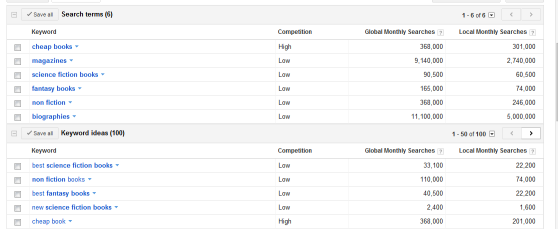Today we’re going to start a series that helps first-timers start their own ecommerce business. It’s also relevant to retailers that recently started their business, or they have an established ecommerce business but they want to launch another one.
The order won’t be so clear (for example, you might want to find the perfect ecommerce platform for you before you plan an SEO strategy, but we’ll have an article on that later) but the tips are essential to planning and launching an ecommerce business effectively. Hope you enjoy, and if you have any questions or requests for content in this series, please post them in the comments and we’ll listen & respond. Serious! Here we go:
Ecommerce Websites
Just because you have a website doesn’t guarantee you traffic.
If you’re new to ecommerce, you’ve probably found this out the hard way. Most ecommerce store owners toil away at building the perfect website, expecting to have hundreds of orders coming in the day it launches. Unfortunately, it just doesn’t happen that way.
Like with any site, an ecommerce store takes lots of painstaking effort and SEO maneuvering to build up traffic and customers – but it can be done. If you’re ready to get started with ecommerce SEO on your site, follow these five easy steps to kick-start your campaign:
1. Set a good foundation.
Just like a house, an ecommerce website needs a good, solid foundation in order to stand the tests of time. The first step to doing this is to acquire a great URL, one that conveys your brand, is easy to remember and, ideally, includes a product or service that you offer. For example, if your company was called Jackson Farm, and you sold hammers, a perfect URL for you would be www.JacksonFarmHammers.com. It’s short, easy to recall and quickly conveys what your business is all about.
Another part of a good SEO foundation is analytics. When you’re setting up your site, ensure you have Google Analytics installed and a Google Webmaster account configured. These are both great tools that will help you determine what’s working and what’s not in regards to SEO, allowing you to make changes accordingly. In addition, to really get a glimpse into the effectiveness of your SEO efforts, make sure your site has a built-in search function. This will allow you to view what your visitors are coming to your sitelooking for – an invaluable insight in developing an effective SEO campaign.
This will allow you to view what your visitors are coming to your sitelooking for – an invaluable insight in developing an effective SEO campaign.
And let’s not forget: a good website foundation wouldn’t be complete without a sitemap. Let’s face it, search engine have a lot of work to do; there are millions upon millions of websites out there, and they’re expected to crawl them all on a regular basis. Do search engines a favor by including a sitemap on your site. This will help guide them through your website and alert them as to what pages are most important and most recently changed. Search engines will show you the love back by ranking you more highly!
2. Focus on niche, long tail keywords.
You probably came into this article knowing a little something about keywords: those magic little words and phrases that can mean the different between acquiring a new customer and getting left behind in the proverbial internet dust. But how do you find keywords? And how do you know which ones are right for your business?
To get started, use a keyword-finding tool and begin researching terms related to your company. Good tools to use are:
Search for a combination of general terms and more specific, product-driven terms, looking at the level of competition and the  number of searches that comes up for each. Essentially, you want to choose keyword terms that show a low number of competitors and a high number of searches: that’s an untapped market! Your best bet is going to be with long tail keywords.
number of searches that comes up for each. Essentially, you want to choose keyword terms that show a low number of competitors and a high number of searches: that’s an untapped market! Your best bet is going to be with long tail keywords.
What are long tail keywords, you ask? Let’s go back to our Jackson Farm hammers example to explain this one. Off the bat, being a hammer provider, you might automatically think, “hammers will be one of my keywords.” While you’re right to some extent, that’s not the key to the holy grail of SEO. The term “hammer” is just way too broad; by using “hammer,” you’d be battling against thousands, maybe even millions, of other websites out there selling the same product – possibly even at a lower price. To really gain ground in SEO, you need to focus on more specific, niche keywords. These are called “long tail” keywords.

Look at the difference in results for a basic keyword and a long tail keyword. Which do you think is closer to a sale?
Let’s expound on this. Say you sell a cool brand of hammer called the “Big Mike Hammer.” You’re better served by focusing on the more specific, long tail keyword “big mike hammer,” than the more broad “hammer” term. Why? First of all, you’ll have way less competition. Instead of swimming upstream, fighting against the thousands of sites hoping to sell hammers, you’re competing only against the ones that sell Big Mike Hammers – probably a much smaller segment. Second, you’re bringing in visitors who are closer to buying. If a customer is searching for “Big Mike Hammer,” they know exactly what they’re looking for already. There’s no browsing, no time wasting and no deciding. Chances are, if you provide that product, they’ll want buy it.
So go into keyword research with this in mind: the more specific, the better. Long tail keywords like “big mike hammer” may not bring in MORE traffic, but they’ll bring in BETTER traffic – traffic that converts into sales!
3. Infuse your website with your keywords – everywhere.
Once you determine which long tail keywords you want to use, it’s time to start optimizing your site. This doesn’t just mean putting together some Meta descriptions, keywords and titles (which you should do, by the way!), it means infusing your entire website with them. Your keywords should be a part of every inch of your website, from file names and photo tags all the way down to your URL structure.
Most importantly, your keywords should be a part of your site content. Product descriptions, copy on static pages and photo captions should all include your keywords in some form or fashion. The more your site is associated with those terms, the better your ranking will be.
But don’t just throw keywords around willy nilly! Your copy should be readable and flow easily. Ensure your keywords are worked into your site naturally and that they don’t stick out like a sore thumb!
4. Get your site name out there.
Once you’ve worked your keywords into your website (on-site optimization), it’s time to work on getting your site out there through some off-site optimization. First, start link building. List your website in online directories, start social bookmarking, and seek out reciprocal links from similar sites within your industry. Typically, a search engine will consider a combination of link-related factors when determining your site rank: the number of links coming in to your site, the quality of the linking sites, and the theme or topic of those sites. So keep this in mind when link building. You don’t just want links for link’s sake. You want links from high-traffic, reputable websites that are relatable in theme to what your site offers.
Another great way to optimize your company off-site is through social media. Search engines give high value to social websites in search results because they’re authentic. They’re real people sharing real thoughts, information and opinions – exactly the kind of results search engine seek to provide users.
Social sites you should be on include:
- Google+
An added benefit of info posted on social media sites is that it’s easily shareable. That means anyone who sees your Facebook or Twitter update can easily share it with their social circle, giving your brand more exposure and more potential customers. And don’t forget to use your keywords when utilizing social media! The more your site name is associated with those keywords, the higher you will rank.
You can also give products to popular bloggers for free and ask them to review it on their blog in return. In fact, the more giving you can be with your products, without even asking for something in return, you’ll find that you will make a friend or two very quickly in the blogging world who will want to write about your products and company.
5. Start a blog, and publish new content regularly.
You’ve heard the old saying “out of sight, out of mind,” right? Well, this same sentiment applies to SEO, too. If you’re not consistently reminding search engines that your site is out there, you’re going to get forgotten, left behind and pushed down in the search rankings.
So how do you remind Google that your site is out there? It’s easy: post regular, fresh content. Better yet, post regular keyword-rich content to enforce those handy dandy long tail keywords you found.

To really get the most from your website, you should be posting new content at least every few days. Now this might sound daunting, but there’s a simple and easy way you can make this happen: start a blog. A WordPress or Tulmbr-hosted blog installed on your site can make for a quick way to add fresh content with little to no hassle. Use it to discuss industry news or post company updates, share funny photos or promote your latest sale – whatever fits your company and brand best. Just remember, be sure to integrate those long tail keywords you worked so tirelessly to determine!
Integrate those keywords seamlessly and unnoticeably into your blog copy, and you’re getting a two-for-one deal: keyword exposure + new content for search engines to crawl! You’ll be an SEO goldmine in no time.
Once you’ve made it this far, you’re ready for the next step in your ecommerce SEO saga. Make sure you check out this SEO roundtable from some of the biggest SEOs in the business.
What’s worked for you? Post a tip and get free ecommerce advice from the CPC Strategy team!
You Might Be Interested In












